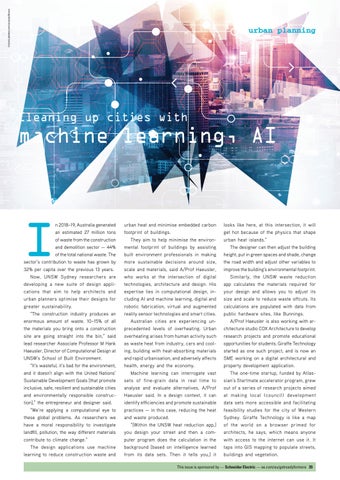©stock.adobe.com/au/peshkova
urban planning
Cleaning up cities with
machine learning, AI
I
n 2018–19, Australia generated
urban heat and minimise embedded carbon
looks like here, at this intersection, it will
an estimated 27 million tons
footprint of buildings.
get hot because of the physics that shape
of waste from the construction
They aim to help minimise the environ-
urban heat islands.”
and demolition sector — 44%
mental footprint of buildings by assisting
The designer can then adjust the building
of the total national waste. The
built environment professionals in making
height, put in green spaces and shade, change
sector’s contribution to waste has grown by
more sustainable decisions around size,
the road width and adjust other variables to
32% per capita over the previous 13 years.
scale and materials, said A/Prof Haeusler,
improve the building’s environmental footprint.
Now, UNSW Sydney researchers are
who works at the intersection of digital
Similarly, the UNSW waste reduction
developing a new suite of design appli-
technologies, architecture and design. His
app calculates the materials required for
cations that aim to help architects and
expertise lies in computational design, in-
your design and allows you to adjust its
urban planners optimise their designs for
cluding AI and machine learning, digital and
size and scale to reduce waste offcuts. Its
greater sustainability.
robotic fabrication, virtual and augmented
calculations are populated with data from
“The construction industry produces an
reality sensor technologies and smart cities.
public hardware sites, like Bunnings.
enormous amount of waste. 10–15% of all
Australian cities are experiencing un-
A/Prof Haeusler is also working with ar-
the materials you bring onto a construction
precedented levels of overheating. Urban
chitecture studio COX Architecture to develop
site are going straight into the bin,” said
overheating arises from human activity such
research projects and promote educational
lead researcher Associate Professor M Hank
as waste heat from industry, cars and cool-
opportunities for students. Giraffe Technology
Haeusler, Director of Computational Design at
ing, building with heat-absorbing materials
started as one such project, and is now an
UNSW’s School of Built Environment.
and rapid urbanisation, and adversely affects
SME working on a digital architectural and
health, energy and the economy.
property development application.
“It’s wasteful, it’s bad for the environment, and it doesn’t align with the United Nations’
Machine learning can interrogate vast
The one-time startup, funded by Atlas-
Sustainable Development Goals [that promote
sets of fine-grain data in real time to
sian’s Startmate accelerator program, grew
inclusive, safe, resilient and sustainable cities
analyse and evaluate alternatives, A/Prof
out of a series of research projects aimed
and environmentally responsible construc-
Haeusler said. In a design context, it can
at making local (council) development
tion],” the entrepreneur and designer said.
identify efficiencies and promote sustainable
data sets more accessible and facilitating
practices — in this case, reducing the heat
feasibility studies for the city of Western
and waste produced.
Sydney. Giraffe Technology is like a map
“We’re applying a computational eye to these global problems. As researchers we have a moral responsibility to investigate
“[Within the UNSW heat reduction app,]
of the world on a browser primed for
landfill, pollution, the way different materials
you design your street and then a com-
architects, he says, which means anyone
contribute to climate change.”
puter program does the calculation in the
with access to the internet can use it. It
The design applications use machine
background [based on intelligence learned
taps into GIS mapping to populate streets,
learning to reduce construction waste and
from its data sets. Then it tells you,] it
buildings and vegetation.
This issue is sponsored by — Schneider Electric — se.com/au/getreadyformore 39
